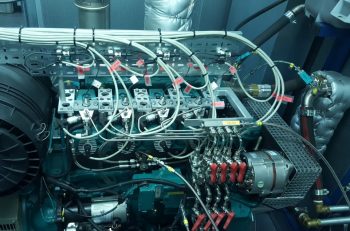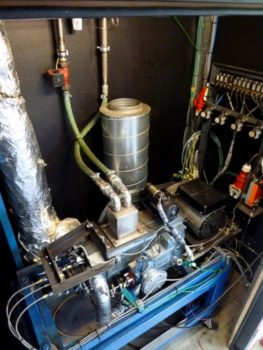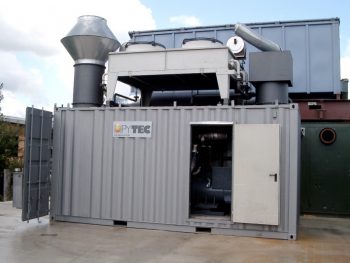Key Points
- Stationary compression ignition engines are being modified to operate with bio-oils as fuel
- Bio-oil fired diesel engines can be applied in stationary applications to provide heat and electricity
- Modifications include fuel diluents, pilot and pre-start fuels, corrosion resistant parts, preheating, and compression ratio changes.
Further Reading
- PyNe 41: van de Beld on diesel engine firing of raw bio-oil.
Example Applications
Engine development at BTG

Modified 4 cylinder diesel engine running on neat bio-oil at BTG (PyNe 41)
BTG has modified two compression-ignition engines to develop this application, viz. a one-cylinder and a four-cylinder prototype. Initial work was done with the 1-cylinder engine which has the advantage that only 1 fuel injection system needs to be constructed and installed. More recently, the modification of the four cylinder engine started which can be seen as a prototype for a commercial size CHP system.
The original 1-cylinder CI-engine, which has been adapted to run on bio-liquids including pyrolysis oil (see www.bioliquids-chp.eu). Obviously, some modifications are needed to run the engine on pyrolysis oil, and the most important one concerns the fuel injection pump and fuel injector; both have been made from a special stainless steel.

Single cylinder diesel engine modified to run on neat bio-oil at BTG
The new 4 cylinder engine prototype is based on the Weichai 226B engine, and the complete gen-set has been assembled and supplied by ABATO Motoren BV, the Netherlands. Subsequently, the unit has been modified by BTG to enable FPBO fueling. Four corrosion resistant fuel pumps and fuel injectors have been constructed in-house. The fuel pump is a two-stage system meaning that the original fuel pump is driving a 2nd fuel pump. The latter pump is connected to the fuel injector, and direct contact of FPBO with original parts of the engine is avoided. To overcome the poor ignition of FPBO the incoming air can be preheated; the compression ratio is kept to the original value of 18.
The engine is started on diesel, and subsequently the inlet air heater is switched on. If the engine is running smoothly and stable the fuel type is switched to rinsing liquid (ethanol or butanol) and engine will run for 5 or 10 minutes on this fuel. Finally, the switch is made to FPBO. So far all tests have been carried out with FPBO containing 20 wt% ethanol. The FPBO was produced by the Empyro plant from woody biomass.
The major modification to the engine concerns the fuel feeding pumps and fuel injectors. To evaluate the new components their performance has been compared to the standard ones. Initially, reference runs have been carried out with diesel and the standard fuel pumps and injectors. Next, only the four fuel pumps were replaced with the modified fuel pumps, and the test runs were repeated with diesel as fuel. Finally, the new fuel injectors were installed and the same tests were carried out again. Tests were carried out at different engine loads (up to 20 kWe) and different air inlet temperatures (50 – 200 °C). The new system leads to a lower NOx content probably due to some delay in the fuel injection caused by the indirect pump system. A small change in the fuel injection timing might be implemented to get similar performance.
The fully modified 4 cylinder system was tested with different fuels including diesel, butanol, ethanol and FPBO. Obviously, due to the lower heating value the consumption of FPBO will be the highest, and the specific fuel consumption will decrease with increasing load.
Besides pure pyrolysis oil, a number of upgrading techniques have been applied to improve the properties of pyrolysis oil, like blending, hydrotreatment, emulsification and esterification. All these ‘upgraded’ pyrolysis liquids have been tested in the engine. Generally, the upgraded liquids were easier to ignite resulting in lower CO emissions and higher NOx, whereas the effect on overall efficiency was less pronounced. However, the liquids remained acidic, and therefore a modified injection system will still be required in all cases.
Long-term testing of pyrolysis oil fuelling will become necessary. CO emissions and pyrolysis oil fuel consumption were followed for a period of 40 h without a clear change in engine performance and emissions. Obviously, for further development and commercialization real long duration testing will be important (> 400 h).
In summary, it can be concluded that the 4 cylinder engine has successfully been modified to enable FPBO fueling. In 2017/2018 an extensive test program will be carried out to continue the development.
References
Bert van de Beld, Elmar Holle and Jan Florijn, An experimental study on the use of pyrolysis oil in diesel engines for CHP applications, 19th European Biomass Conference and Exhibition, Berlin-Germany (2011) 1181 – 1187.
Bert van de Beld, Elmar Holle and Jan Florijn, The use of pyrolysis oil and pyrolysis oil derived fuels in diesel engines for CHP applications, Applied Energy, 102 – issue C (2013) 190 – 197.
Bert van de Beld, Elmar Holle and Jan Florijn, The use of fast pyrolysis oil in diesel engines for CHP application, 25th European Biomass Conference and Exhibition, Stockholm-Sweden (2017) 1932 – 1937.
Bert van de Beld, Elmar Holle and Jan Florijn, The use of fast pyrolysis oil in diesel engines for CHP application, submitted to Biomass & Bioenergy (2017).
Engine development and testing by Wärtsilä and VTT
The first work on using pyrolysis liquid in diesel engines was carried out in Finland by VTT and Wärtsilä. Engine performance and emissions were studied in a 4.8 kW single-cylinder test engine, in a 60 kWe four-cylinder Valmet 420 DS-engine and in a 410 kW Vasa 18V32 engine using one of its 18 cylinders on pyrolysis liquid. It was observed that:
- Pilot injection of diesel oil is needed.
- Fast heat release of pyrolysis liquid is observed.
- Encouraging thermal efficiency of 44.9% was achieved
- Specifications laid down on the properties of the pyrolysis liquid have to limit the solids content to a very low level and must provide tight heating value control
- Water content of pyrolysis liquid evens out the temperature gradient and is beneficial for NOx reduction
- The high density and low heating value of pyrolysis liquid has to be carefully considered when designing the fuel feeding system.
- Severe material wear occurs.
Wärtsilä’s 1.5 MWe medium-speed diesel power plant was modified for pyrolysis liquid use based on the experience gained in the earlier studies. A pyrolysis liquid feeding tank and feeding unit was constructed. The injection rate – injection system had been developed to 1450 bar and less than 30° injection period (6.7 ms) using the extreme fuel properties of 15 MJ/kg heating value and 1.2 kg/L density. Handling, quality control, feeding, and behaviour of a large amount (100 tonnes) of pyrolysis liquid were studied. The main results were as follows:
- All standard gaskets in the feeding system and seals in pumps could not tolerate the low pH of the pyrolysis liquid.
- The day/feed tank should be equipped with efficient mixing and temperature control to avoid segregation of the pyrolysis liquid.
- No direct heating of pyrolysis liquid allowed, preheating <90°C needed for viscosity reduction, minimum pyrolysis liquid re-cycling.
- In order to avoid lacquering at pistons or nozzles, the lubricating properties of the pyrolysis liquid should be improved and/or the lacquer forming compounds removed from the liquid.
- To prevent problems with the leakage of pyrolysis liquid to the lubricating oil side, a centrifuge in the lubricating oil line should be considered.
- Before carrying out large-scale diesel-engine tests, more R&D on the fuel feeding line and the injection nozzle system in a test-rig was recommended.
Wärtsilä stopped the development work mainly due to poor quality (i.e. high solids content) of pyrolysis liquids of that time.
References
Jay, D. C.; Rantanen, O. A.; Sipilä , K.; Nylund, N.-O. Wood Pyrolysis Oil for Diesel Engines. Proceedings of the ASME Fall Technical Conference, Milwaukee, WI, September 24-27, 1995; American Society for Mechanical Engineers (ASME): New York, 1995.
Chiaramonti, David; Oasmaa, Anja; Solantausta, Yrjö; Peacocke, Cordner. 2009. The use of biomass derived fast pyrolysis liquids in power generation: engines and turbines. 26 p. Publication No. 561 http://www.vtt.fi/inf/julkaisut/muut/2009/P561_2007_Chiaramonti.pdf.
Oasmaa, Anja, Peacocke, Cordner, Gust, Steven, Meier, Dietrich, McLellan, Richard. 2005. Norms and Standards for Pyrolysis Liquids. End-User Requirements and Specifications. Energy & Fuels, Vol. 19, Nr. 5, Pp. 2155-2163 doi:10.1021/ef040094o.
Engine development and testing at Pytec

Pytec Plant
German company Pytec is developing CHP systems based on the use of fast pyrolysis oil in diesel engines. Their fast pyrolysis process is applying the so-called ablative pyrolysis principle. Instead of a heat carrier, the biomass is contacted with a hot metal surface. The bio-oil is combusted in a modified 450 kWe diesel engine (Mercedes-Benz).
Prior to injection the oil is preheated to 70°C to lower its viscosity and about 4% of diesel fuel was mixed with the pyrolysis oil to ensure lubrication and smooth combustion. The engine was started on diesel and then the bio-oil portion was slowly increased to 96%. In total 10 h of operation have been achieved. On average 120 l/h of bio-oil were consumed achieving an electrical output of 305 kWe and a reduction in exhaust gas temperature of 150°C compared to diesel combustion (derating).
Reference
Practical results from Pytec’s biomass to oil (BTO) process with ablative pyrolyser and diesel CHP plant, Dietrich Meier, Stefan Schöll, Hannes Klaubert, Jens Markgraf, Success & visions for Bioenergy, ISBN 978-1-872691-28-2.


